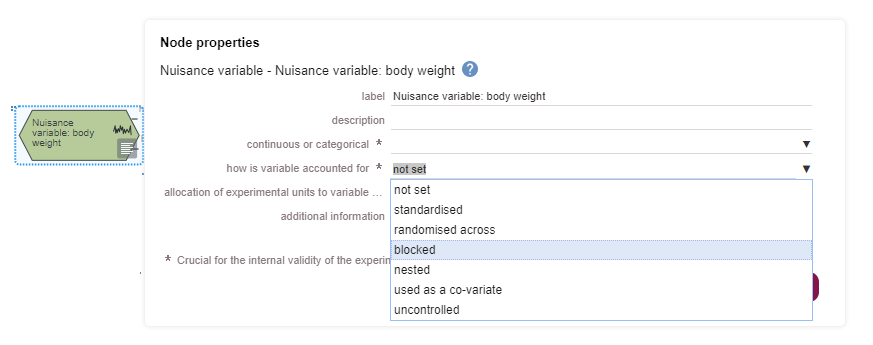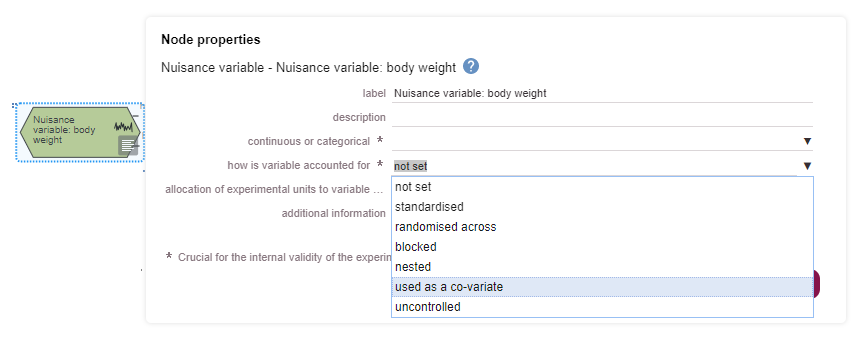This nuisance variable is a covariate but used as a blocking factor in the analysis
In the properties of this nuisance variable, how variable is accounted for is set to ‘used as a covariate’ but it is connected to an analysis node with the link ‘is blocking factor for’. Using this link indicates that the nuisance variable will be taken account of in the analysis as a blocking factor. It is possible to use a nuisance variable as a blocking factor in the random allocation and as a covariate in the analysis. In order for the system to treat this nuisance variable as a covariate in the analysis it should be connected to the analysis node with ‘is covariate for’ as this information is used to generate a recommendation regarding appropriate methods of analysis.
Including a covariate in the analysis allows the variability associated with a continuous nuisance variable to be accounted for. This may be done if experimental units differ due to the influence of a continuous numerical value that is not readily controllable. Examples of independent variables that can be used as covariates include a pre-treatment measure of the response of interest, baseline body weight or age of the animal or baseline locomotor activity.
The nuisance variable can be included in the analysis either as a blocking factor or as a covariate. There are a few reasons for choosing one over the other:
- If the factor is clearly a categorical factor, then it should be a blocking factor (i.e. pieces of equipment, days of the week).
- If the factor can be either categorical or continuous (i.e. bodyweight) then the covariate only needs 1 degree of freedom whereas the blocking factor needs b-1 degrees of freedom (where there are b blocks). This might be an important consideration in designs with small sample sizes.
- Covariates need linear relationships between the response and the covariate whereas blocking factors don't.
More information about covariates can be found in the Independent variables section of the EDA website.
How to fix the diagram
If you want to treat this nuisance variable as a covariate
To indicate that a nuisance variable is used as a covariate in the statistical analysis, it should be connected to the analysis node, with a link ‘is_covariate_for’. Note that some variables can be considered as either continuous or categorical. For example, body weight can be considered categorical (categories: 'low weight' and 'high weight') or continuous, thus body weight could be treated as categorical and included as a blocking factor in the randomisation, and then treated as continuous and included as a covariate in the analysis. If the nuisance variable is used as a blocking factor in the randomisation and as a covariate in the analysis, it should be connected to the allocation node with a link ‘is_blocking_factor_for’ and the analysis with a link 'is_covariate_for'. In the properties of a nuisance variable, the fields 'continuous or categorical' and 'how is variable accounted for' relate to the analysis. For example, if a nuisance variable ‘body weight’ is included as a blocking factor in the allocation (i.e. animals in the 'low weight' and 'high weight' categories are randomised into treatment groups separately) and as a covariate in the analysis, then in the properties of this nuisance variable, ‘continuous or categorical’ should be set to ‘continuous or discrete’.
The link to the analysis node can be altered by clicking on the link, this will make a red spanner icon appear. Click on the spanner icon to display the dropdown menu allowing you to select the 'is_covariate_for' link.

If you want to treat this nuisance variable as a blocking factor
The variability associated with a categorical nuisance variable can be accounted for by including it as a blocking factor in the statistical analysis.
Including a blocking factor in the randomisation is a way to ensure that treatment comparisons are not influenced by known nuisance effects. Including this blocking factor in the statistical analysis allows the variability induced by that nuisance variable to be taken into account. For example, if all the results are higher on a Monday than a Tuesday, and each treatment is allocated to animals on both days, then the within-group random variability will be inflated by any overall day to day differences. Including Day as a blocking factor in the analysis allows this nuisance source of variability to be taken into account and hence prevent it inflating the underlying estimate of the variability of the data. This increases the precision of the effect of treatment, thus increasing the ability to detect a real effect with fewer experimental units.
If the nuisance variable is going to be treated as a blocking factor in the analysis ‘how variable is accounted for’ should be updated to ‘blocked’ as shown in the image below.

If the nuisance variable is going to be treated as a blocking factor in the analysis it should be treated as categorical in the analysis also. This can be indicated in the properties of its node as shown in the image below.

In some instances a baseline measure, that is used to generate the levels of the blocking factor, can also be used to transform the data. For example, baseline bodyweight can be used as a blocking factor in the randomisation (where the blocking factor categories are low, medium and high) and animals are assigned to blocks based on their actual baseline bodyweight. The actual baseline bodyweight can also be used to transform the outcome measure - expressed as percentage of the baseline bodyweight. In this case it is not crucial to include the baseline body weight as a blocking factor or covariate in the analysis. Instead a data transformation node should be added to the diagram as shown in the image below.

This issue may cause other prompts to be triggered inappropriately, please disregard other warnings. Once you have modified the diagram, please critique it again.